Outranking your competition can be very difficult, especially if your website is rather new. What’s even more frustrating is when you can’t outrank competitors which have spammy backlink profiles. Why doesn’t Google penalize them? Why does it rank you lower than them in the Google search results, even though you play the game by the book?
Google’s algorithm has evolved a lot over the years. The main purpose of the improvements was to be able to better distinguish natural links from artificially generated links. Unfortunately, although big advancements have been made, top ranking websites with clean link profiles aren’t always the case.
It probably happened to you (or to someone you know) to run a business in compliance with all Google’s guidelines when it comes to link building but, at the end of the day, to be dethroned by other sites from the industry with spammy link profiles. So, why is this happening? Let’s find out!

- Why Do Sites With Spammy Link Profiles Still Rank Well?
- Why You Should NOT Build Spammy Links as Well
- Google Penguin 4.0 Update & the Disavow Tool
- How to Submit a Spam Report
- How to Outrank Competitors That Have Spammy Link Profiles
If you think I’m going to say that you can still improve your rankings using BlackHat SEO link building tactics in 2019, you’re wrong. But while some complain about their websites being penalized, others have a completely different issue:
“My competitors have spammy links but still rank better than me.”
Then, almost every time, the following question follows:
“What should I do in this case?”
There’s even an old Reddit thread about this:
If you’ve been struggling with this issue for a while, then you’ve landed on the right page.
The short answer to this question is that a spammy link profile doesn’t necessarily mean a website shouldn’t rank well. You see, Google’s (and other search engines) main purpose is to return the best search results for the users, not the search results with the best link profile. There are hundreds of other factors that are taken into consideration by Google when it ranks a website, and although links are still one of the top 3 most important ones, they aren’t everything.
Google has shown signs of steering away from links. Although links can’t completely be removed from the equation (at least not very soon), other factors, like user interaction, for example, have shown a lot of prominence recently.
If the top competitors have spammy backlinks but are still ranking good, well, my friend, then the truth is you’ve gotten yourself into a very competitive niche.
However, there’s still hope. But it’s not going to be easy, nor is it going to be cheap (is anything easy and cheap in digital marketing?). Before we dig into the tips and tricks, let’s better understand what Google has done against link spam over the years, and why.
Why Do Sites With Spammy Link Profiles Still Rank Well?
Ok, so if Google tries so hard to get spammers down, how come some webmasters with such obvious shady link profiles are still ranking well with their websites?
John Mueller from Google tells us that we don’t really know if they got away with it or not.
However, this often sounds unfair, as those websites clearly have spammy link profiles, but are ranking very well.
There could be a thousand reasons why this is happening, but I’ll try to provide some clearance with what I think is happening.
They Built Those Links Long Time Ago
Back in 2012, the BlackHat industry was thriving. ScrapeBox, GSA, Comment Spamming, Private Blog Networks, you name it. It worked. And people got hooked.
BlackHat SEO services were expensive because they could also be very profitable. Even big brands got into them as well.
The ones who suffered most were innocent business owners that had no idea about this. They just signed contracts with SEO agencies to get their websites higher on Google.
As the word spread, more and more shady things started to happen. It wasn’t a time when search engines provided the best results. And Google didn’t like that, so it took action against it.
Many of them lost their rankings forever. Some eventually recovered, through complex actions of improvement and link disavowing.
But some got away with it, and they’re probably still ranking today. Since the algorithm is now supposed to be real-time and to ignore spammy links, this kind of makes sense.

It doesn’t mean they are bad websites or that they still use BlackHat SEO strategies. It could just be that they got away with it. They were lucky.
They Didn’t Build Those Links (Negative SEO Attack)
Sometimes, instead of working on their own websites, people prefer to ‘work’ other websites out, by trying to attract Google penalties to them. These techniques are called Negative SEO Attacks.
In theory, the process is pretty simple: do BlackHat SEO to another website until Google gives it a penalty. When they drop, you replace the spot.
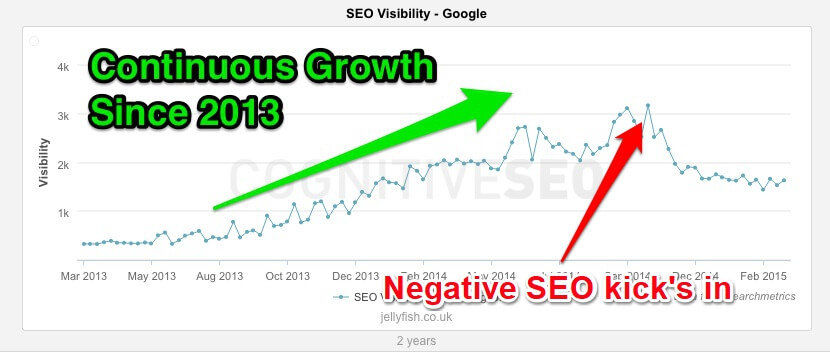
Example showing a negative SEO attack happening on Jellyfish’s website
When you look at a website and see a lot of spammy links, you might say they’re cheating. But although you can analyze a site’s link profile, you have no idea if they disavowed those links or not.
The Google Disavow tool is really useful, but it’s also one of the smartest moves Google made for improving their algorithm.
Because they feared the penalty, many webmasters started submitting their spammy links through the disavow tool.
Sure, it could help you not get penalized, but yet again, it could do nothing. Some even lose rankings after they start disavowing links.
What the disavow tool might actually do is that it feeds Google thousands of patterns of spammy links. So Google gets smarter and smarter every day. Smart, eh?
Negative SEO attack patterns are anyway different from shady link building patterns. You might think that’s not the case, but the truth is when people are doing black-hat SEO for themselves, they’re very cautious and try to stay under the radar. On the other side, when they’re framing someone else, they’re too obvious.
That’s the big downside of negative search engine optimization. If you make it obvious, Google will know it’s a negative SEO attack, but if you don’t make it obvious enough, who knows, your competitor might never get caught and the spam might actually help him rank.
So although you can see your competitor’s backlinks are reall spammy, you can’t know for sure how Google sees the situation.
They’re Still the Best Site Out There
As I said, a spammy link profile doesn’t mean a site shouldn’t be first on Google. This usually happens when all the other sites also have a spammy link profile.
Google can’t penalize all the websites if they’re all breaking the rules because it wouldn’t have any search results left to return.
If the top website has been there for years, providing value and good services to its customers, Google will reward it by keeping it there, even though maybe it knows they’re breaking the rules.
Google Hasn’t Caught Them… Yet
Asking why Google doesn’t penalize all the spammers is like asking why doesn’t the police bust all drug dealers. It’s just too many of them, and it’s impossible for Google to catch them all right away. But it probably will, eventually…
Spamming is still profitable because it works. If you manage to spam under the radar, you might cash in some quick profits. But the frustration of constantly being on the run isn’t a nice feeling.
If you haven’t done it yet, go ahead and read The Confessions of a Google Spammer on InBound. Once Google finds you, it’s over. And they have to start all over again from scratch.

Although I want to say that Google will eventually catch everyone… the reality of life is that sometimes bad guys win.
One Example to Prove Them All
At first, I tried looking for a lot of examples, but without much success. I tried searching the wedding niche, the flowers niche, but time and time the top ranking websites were actually legit in terms of link building.
But then I thought to myself… why not payday loans?
I mean… if there’s a niche there that’s been spammy as hell since forever, it’s definitely this one. Google even has an algorithmic update named after it. And lucky me, I hit the Jackpot (although I couldn’t personally access all the websites; but this could be due to my location).
So I took a couple of sites from the top and one from the second page (United States/British) and used cognitiveSEO to classify the anchor texts and run the Unnatural Link Detection Tool.
The results were promising. The big majority of the links are definitely unnatural.
Another website from a lower set of results shows similar patterns:

Snippet from the Unnatural Link Detection tool showing a competing website from the second page (cashone.com)
However, I can easily back up my points made earlier in the article with this example.
Point no. 1: The sites have been in business for a long time.
You can easily check when websites were registered. It doesn’t necessarily mean that they were in business since that date, but it’s a decent indicator.
These websites were registered over 15 years ago. If the company was doing business back then as well, it’s probably a very legit business with a lot of experience.

Screenshot taken from bulkseotools.com
Point no. 2: The links were made a long time ago.
By checking the link velocity section, we can quickly spot that these websites built links some time ago, but aren’t doing it right now.

Cashone.com’s link velocity; screenshot taken from the cognitiveSEO tool

Mypaydaylonan.com’s link velocity; screenshot taken from the cognitiveSEO tool
The top website seems to be actively building links, but the spike just before 2012 is definitely a lot bigger than the ones happening right now.

Speedycash.com’s link velocity; screenshot taken from the cognitiveSEO tool
Point no. 3: These websites are still offering good services.
Although they still look spammy design-wise, one of the websites has over 2,000 reviews on TrustPilot, showing an average grade of 9.1. They could be fake reviews, of course, but yet again, they could not be. I think TrustPilot are doing their best to keep things real.
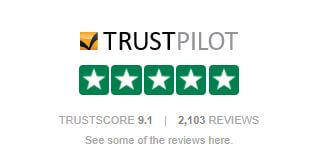
Sure, I didn’t analyze one thousand sites, but I hope I made my point. Chances are that most websites in this niche have a significant amount of unnatural links in their link profiles.
Why You Should NOT Build Spammy Links as Well
I know it’s tempting. I know how you feel. You’ve probably tried everything and they still rank better. But unless you’re trying to go for a hit and run niche site, no. It’s too risky.
Old sites that did BlackHat stuff in the past might still be ranking well in the Google search results, but new sites doing shady stuff attract a lot more attention. You might get penalized right from the start, losing your chance to ever rank for that keyword.
Although building a million spammy links might look easy, it’s not. It takes a lot of effort and the learning curve is quite steep. It’s also not cheap. You’ll need advanced tools and thousands of proxies to cover your ass up.
If you want to beat a BlackHat site the WhiteHat way, then it’s not going to be easy. But the advantage is that you don’t risk anything, and what you build, you build on the long-term.
Your time is far way spent on other things, such as quality content, improving user experience and relationship building. Instead of pointing our fingers at someone else, we should be taking a look at our own actions, and see how we could improve those.
Google Penguin 4.0 Update & the Disavow Tool
If you’ve heard about the Penguin Update, then you probably know it’s triggered by spammy links. Although it’s not the only algorithm that penalizes websites with spammy link profiles, it’s definitely the one that took the most spammers down. If you’re planning on some shady link building, then you should look out for flappy walks and orange beaks.
The problem with the first three Penguin algorithm updates was that although they got better, they were still pretty slow. Google used to gather information over a longer period of time (about 2-3 months) and then roll out a patch that would suddenly impact thousands of websites that broke the rules.
As of the latest version, Google’s spammy link tracking is now happening in real time. With the Penguin 4.0 update, Google ignores spammy links or penalizes single pages instead of penalizing entire websites.
This doesn’t mean that websites can’t be penalized anymore. Plenty of users still admit having suffered from Google penalties that affected their entire websites.
Some experts, such as Rand Fishkin, speculate that Google used this slow mass penalty process to create a fear factor that will determine webmasters to submit their spammy link profiles through the Disavow Tool.
This tool, launched in 2012, some months after the first Penguin update, enabled users to submit links that they wanted to be ignored by Google. People thought that if they submitted their links sooner, they could avoid a possible Google penalty. Google then supposedly fed the Disavow Tool database to the algorithm and used this to create a real-time version of Penguin, one that better understands link spamming patterns.
The Disavow Tool also somewhat protects webmasters against negative SEO attacks. If someone built some spammy links to your site you could start disavowing them. However, Google had previously stated that the Disavow Tool isn’t a replacement for removing links and that no reconsideration action will be taken unless users also try to remove some of those links.
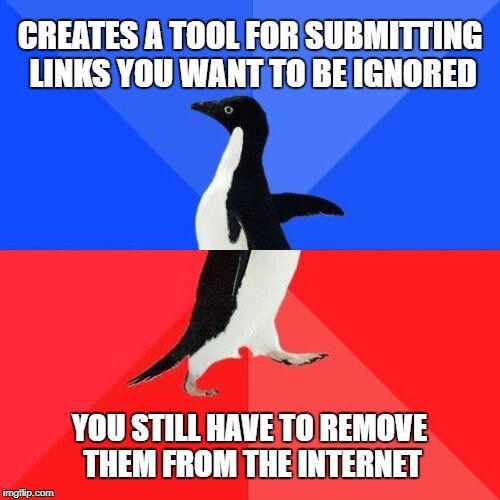
Good ol’ Google! Never fails to surprise you with its tricks, right?
However, the truth is that using the disavow tool can help you recover from a Google penalty. If you’re ever in that situation, it’s worth a try.
How to Submit a Spam Report
Although you can do this, I wouldn’t recommend rushing in. It’s not exactly the same, submitting a spam report does resemble a negative SEO attack because while you could try to outrank your competitor by gaining positions yourself, you’re trying to pull him down instead.
Think about the things I mentioned earlier:
What if your competitor just hired a company to do search engine optimization and he has no idea, although he’d probably be against it if he knew?
In addition, if you have some shady links yourself, or share some of the backlinks with your competitor, submitting a spam report might attract Google’s attention to your website as well. You’ll see why in a minute.
Instead of blowing into some other person’s candles, try to make your own candle burn brighter. The truth is, if you had started doing SEO 5 years ago, you’d be ranking now.
However, if you see a website that tries to steal information from clients and or is involved in any illegal activities ranking on top, then you should definitely submit a spam report, as soon as possible.
In theory, Google employees should manually review these websites and decide if to apply a penalty or not. Any phishing or malware attempts will surely be banned.
There are more types of spam reports. Some of the more… dangerous ones, let’s say, anyone can file. This includes Malware, Phishing or Copyright related issues.
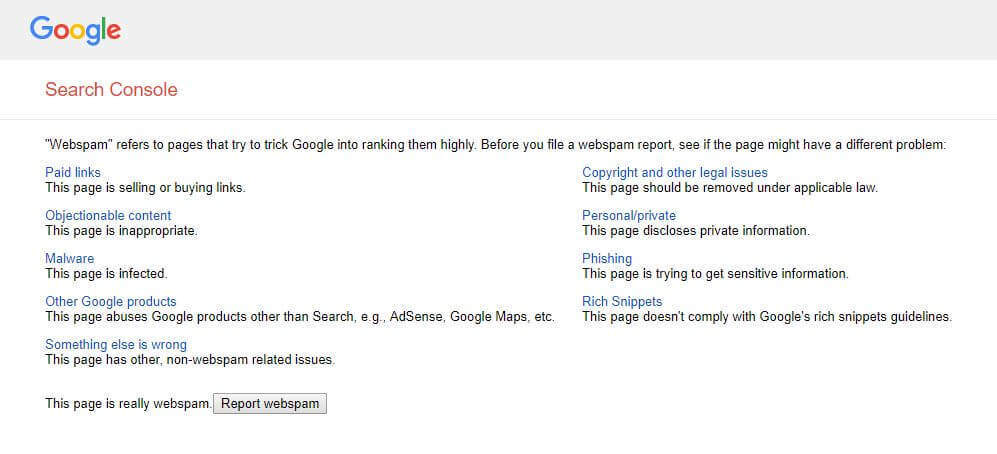
The rest of them, on the other side, will require a search console account (former Webmaster Tools). This means that Google will know exactly who is filing the report. If you ever did some shady things yourself, you should keep this in mind.
Of course, you could just set up a fake account to set a report, but Google will probably ignore those, otherwise an account wouldn’t be required in the first place.
How to Outrank Competitors With Spammy Link Profiles
Even though things aren’t in your favor, you should not give up. There are still things you can do to outrank these types of competitors.
Actually, the journey is one of the things that makes SEO so interesting: figuring out those things you haven’t thought of before; making a move that provides results; doing it without cheating.
Outranking a BlackHat SEO feels like gaining more money and power than the Godfather by selling lollipops.
Focus More on OnPage and Technical SEO Factors
I know this might only sound motivational, but you should shift your focus from links to on-page factors. When people say they’ve tried everything, I still have a feeling they were only talking about link building.
That’s what usually happens when spammy link envy kicks in: you forget about all the other things, like making your website faster, securing the connection with an SSL and improving the overall user experience.
Here’s what you should be asking yourself:
Am I really offering the users a good experience?
One of the hardest things entrepreneurs have to do is jump into their customers’ minds. It’s hard to really see their frustrations and come up with good solutions to solve them. You might’ve heard the phrase “Customers don’t know what they want.” Well, that’s true and it’s exactly the issue! They don’t know what they want so they won’t buy. At least, not until you offer a good solution to the problem.
If you really want to understand the buyer, just go buy something. You’ll instantly shift into the buyer’s mindset. And that’s exactly what you should analyze for your site if you really want to find solutions and make more sales.
What’s your conversion rate? Is it satisfying? Where do your users click most of the time? Is it easy for them to understand what’s clickable and what’s not? Are you offering a live support chat? Are they wasting time looking for something? Maybe you should bring it more to the front.
Am I really trying to solve their problems?
Many websites out there don’t try to solve a problem. They’re just in because they heard you can make some money online. As long as you’re not focused at all on solving a user’s problem, you can’t really improve your website.
Is the content really answering their questions? Does it resonate with who they are? Figure it out before you put another word on your pages.
Is my website better than theirs?
The website must be prettier, faster and easier to use.
However, I’m not talking only about design and website performance . There are a lot of other variables which actually come from outside the website:
Is your brand known at all compared to your competitor’s? Could you really handle all the orders without an issue? How’s your social media engagement compared to theirs?
Really step up your content game
Everyone knows that content is King. But an inconsistent King can quickly lose his throne.
Consistency has proven itself time after time in the content marketing and SEO industry. We’ve experienced this ourselves here, at cognitiveSEO. That being said, get yourself an editorial schedule ready, and stick to it.
It doesn’t really matter how much you post. Obviously, the more, the better. But what really matters is that you post on a daily/weekly/monthly basis.
Remember that with quantity, you risk losing quality. To be able to post more often and keep the quality of your content, you’ll have to expand your writing department.
Think of innovating things in your niche. Analyze your competitors’ content and try to find the content gaps. Set personas for your targeted audience and really dig into it.
One thing I often recommend to websites, especially if it’s an eCommerce site, is to start blog posting. This can help a lot with building the authority of the domain, as articles and blog posts get shares and backlinks much easier than products. You’ll need a good content marketer for that. Some niches have a hard time coming up with interesting content.
Here are some next level tips on how to expand your content strategy, even in a really boring niche. It’s not a short video, but it’s worth watching.
The secret here is finding those questions and objections your clients have that your competitors don’t answer, and answer them! Any gap in the niche that the competition hasn’t filled yet is a great opportunity for you to improve your website.
Another great thing to do is update your content regularly with new information. You always learn new things about different topics. If you think you have new information you can add to an existing article, never hesitate to do it!
A great way to improve your content marketing strategies is using the cognitiveSEO Keyword Tool & Content Assistant. This set of SEO tools works by analyzing all the pages that rank for that keyword and providing keywords that you should add in order to make your article more relevant.
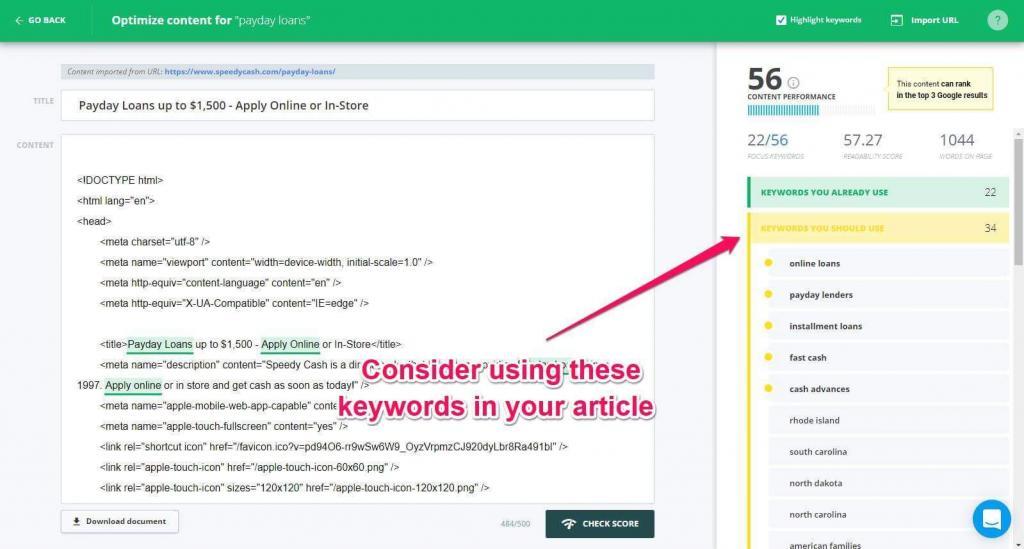
Don’t just bulk keywords in. Think of them as topics you haven’t covered before. Add them to relevant places and always keep the end user in mind. If it doesn’t make any sense for the reader, don’t add the keyword at all.
We’ve optimized our own content recently and the results were promising, providing a 70% increase in SEO visibility.
Look for other keywords to target
Keyword research is really important if you want to do well in SEO. Sometimes, if you can’t outrank your competitors on Google, you can try to target keywords that are less competitive.
Maybe the ones you are targeting right now are not the most relevant for your website and users. Maybe the keyword difficulty is too high for your website’s authority.
You can try targeting some longtail keywords instead. As you grow, your site will get stronger and will be able to target more competitive keywords.
Many times, people get stuck trying to rank for that one great keyword. Sure, high search volume keywords are nice, but there are other keywords out there.
Your spammy competitor can’t be ranking on all of them.
Don’t waste too much time trying to rank on a single keyword, or you’ll end up overoptimizing and doing yourself harm. You’ll also waste a lot of time and lose opportunities to rank hundreds of other keywords.
The cognitiveSEO Keyword Tool can provide you with some new keyword ideas that you can start targeting. The ones with more stars are more relevant to your primary searched keyword.
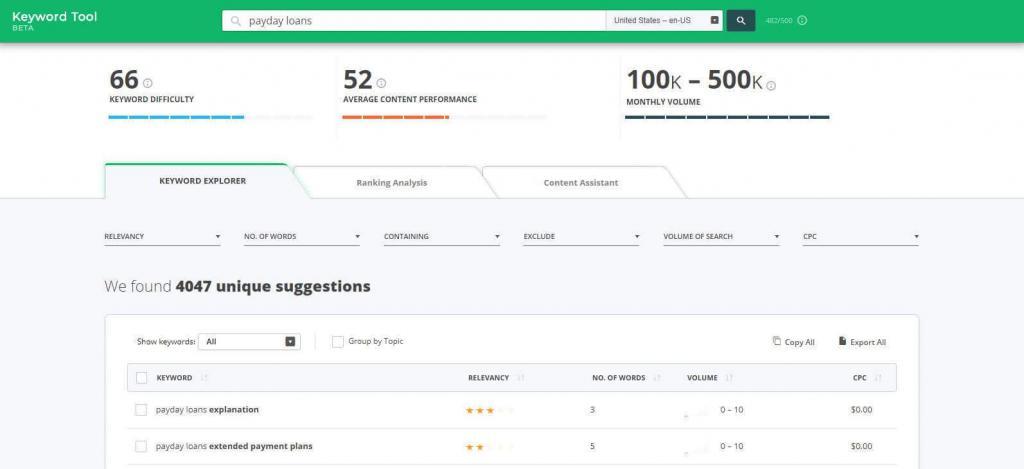
Snippet from the cognitiveSEO Keyword Tool
Another interesting trick you can do is to use the Site Explorer to find the Top 10-20 ranking keywords for a website. Not so useful if you use it on your own site, but if used on a competitor’s website, you can get new insights you probably haven’t thought of before.

Snippet from cognitiveSEO’s Site Explorer showing a website’s top ranking keywords
Another good way is to simply use the basic Google Keyword Planner. However, to get more accurate keyword statistics, you’ll need to spend some money on advertising, using Google Adwords.
Speaking of Google AdWords…
Invest in Advertising
If you’re not moving, you’re staying put. That’s exactly what you’re doing if you’re obsessing over a competitor’s backlink profile.
If you can’t outrank them and get enough traffic from SEO strategies alone, then you might need to invest in advertising. You can advertise either with Google Ads or on Social Media.
And did you know that there are ads that help you rank better on Google? Yes, it’s called buying links.
You can buy links without breaking any of Google’s guidelines by simply nofollowing the links. The secret is to make them site-wide and make it obvious it’s an ad.
Countless examples prove that nofollow links still provide SEO value. The best thing about it? You can actually use your target keywords in the anchor text!
If you think it works for you, you might even try using some press releases. Just make sure they are from reputable news sites.
Make sure you also strengthen your brand if you have enough budget to advertise. Maybe place an image ad as well using your brand logo near the link. Smart ads also have the chance of getting viral, especially in the video field.
Invest in it the white-hat way, and nofollow those links!
Improve your social media campaign
Although social media has been going down as a referral source (and Google has been climbing), it’s still a good idea to invest your time into building a social following. People spend a lot more time on social media than they spend on Google, and you need to be there.
Your competitors might spend a lot of time building shady links, but they might suck at social media. We don’t know for sure if social signals are a direct Google ranking factor or not, but they can have an impact on organic traffic, which can lead up to more natural links (a real ranking factor).
Maybe your competitor isn’t doing anything interesting on Facebook. You could, for example, bring something new by building yourself a chatbot. Chatbot marketing works well because the open rates for the messages are really high (up to 90%).
Get inspired from your competitor’s good links
The only time you should spend on analyzing the competitor’s links is if you want to spot opportunities for yourself.
Spending too much time on a competitor’s backlinks profile is a waste. You could instead spend that valuable time to figure out new issues on your website and fix those.
The reality is that not all the links on a spammy profile are bad.
Links usually cause higher rankings, but it can also be the other way around. As websites start ranking, they get more organic traffic which can lead to more links being created, as people discover and share your content around. And those are strong, natural links.
If a site has been ranking #1 for a long time, I bet there are some natural links in their profile as well.
You can dig for those natural links and try to replicate them. This, of course, if you have a better website. Nobody will link to you if they don’t find the website and the info on it useful.
You can use the cognitiveSEO’s Unnatural Link Detection Tool to spot this kind of opportunities. Just run the backlink analysis, identify the good links and try to build them or earn them by contacting the owners.

Access the natural link navigator by clicking on the green bar
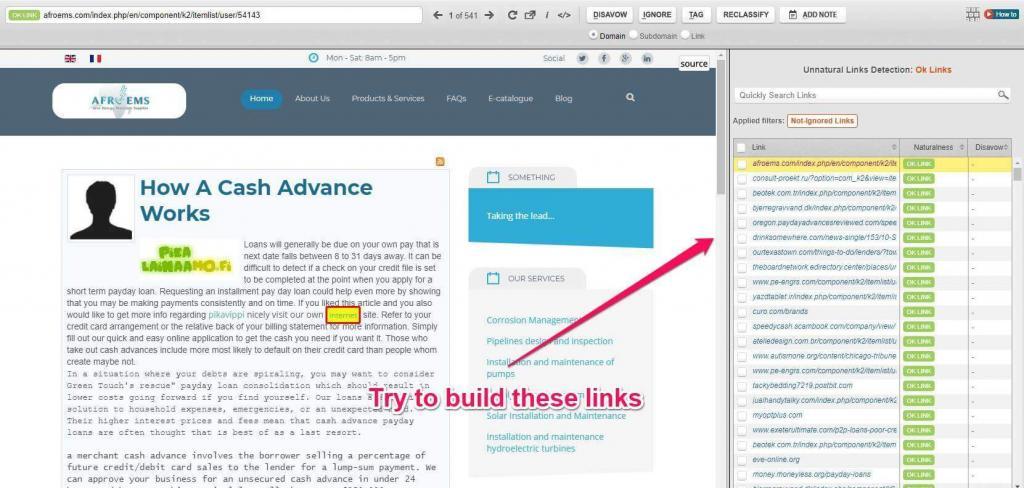
Steal your competitor’s natural links
However, no matter how many online learning platforms that speak about building links you’d attend, keep in mind that your primary focus shouldn’t be on link building. Stealing your competitor’s links is a great link building strategy, but earning them naturally is an even better one. If you start improving all the things mentioned above, links will start coming on their own.
Conclusion
Outranking your competition isn’t an easy job, but it’s often something that needs to be done in the digital marketing world. Shifting your focus from building links to improving other things about your website (such as OnPage SEO and the conversion rate) can make the process less frustrating and a lot more effective.
Make your website better by adding more relevant content and by analyzing and improving the overall user experience. Try to gain a little traction from other sources of traffic, such as Google Ads or Social Media. Work on your conversion rate optimization and keep your customers happy.
Try to fill any gaps you can spot in the niche that your competition isn’t yet taking advantage of, and most of all, try to have a better site than they do, not just a better ranking one.
As Rand Fishkin once said, “F@%# Link Building!” Start link earning.

 Site Explorer
Site Explorer Keyword tool
Keyword tool Google Algorithm Changes
Google Algorithm Changes



Great article Adrian. Interesting use of the tools. Looking forward to trying out your suggestions to beat those lucky spammers in the top 3 spots 😉
Glad you liked it, Alan! I sure do hope you outrank them! Spam is like cancer for the internet… very hard to treat 🙁
Its crazy that the spammy links can have an impact, I had been wondering about how that worked. Great article Adrian appreciate your input.
I think it’s more crazy that people like Matt Cutts managed to trick so many into believing that “spammy links” are all bad and will only ever hurt a website. Don’t get me wrong, I don’t think spamming is a good idea in the long run, but there’s no denying it can be effective in the short term when done correctly.
If you want really hardcore examples, just look at the backlink profiles of sites that sell Cialis or fake NFL jerseys or other things like that where people employ all sorts of insane blackhat methods.
Thanks a lot, Shane. I really hope this helps webmasters struggling with spammy competitors 🙂
They will spam everything.
Negative SEO is a problem many of the bloggers. We have seen many sites of getting negative SEO attacks.
Thanks for the post.
I don’t do black hat SEO because I love getting a good night sleep 🙂
Adrian, Great article. Clearly there are a lot of white-hat SEO professionals adhering to best practices set forth by Google’s Guidelines that have to compete against those who practice more aggressive backlink manipulation tactics. I’ve found that the SEO industry is among the most widely abused area. It makes sense that this would be the case because those practicing SEO know the ins and outs of how to rank with both black and white hat tactics. Thank you for providing the video with John Mueller. It shows the level of frustration in our profession.
Nice to see you here, John! Thanks for your input! 🙂 Yes, SEO is widely abused, not only in the US but in Romania as well. Yeah, sometimes it’s hard to accept their answers. I mean I understand John that he can’t disclose everything, but I once asked him about how Google figures out if the content is original, and he said that that’s not Google’s problem and that I should file a DMCA if someone steals my content. 🙁
Hi,
It is a very interesting article. In our business (casino) we also see a lot of spam. Some websites still hide links on international university’s for example. We try to build a good backlink profile for our website, but sometimes it is very frustating that other website will rank so easily…
We also have a hughe focus on our On Site SEO. Thanks for the article.
Casinos and Porn are probably the most abused. Although I’m not recommending you should build blackhat links, I think that Google also takes a look at the industry standard before penalizing anyone. Usually, to be able to compete with big websites in competitive niches, you have to think outside of SEO… SEO is more about marketing and persuasion these days.
Using spammy link can be challenging and time consuming. This is way more effective.
Hi Adrian,
this post speaks to me. I’m currently trying to beat a black hat guy that’s ranking on the first page with cheap PBN’s and injected links in the edu sites.
It’s really frustrating to see that and think how Google can’t see it.
For example that injected link not only is on a totally unrelated page, but is actually hidden from view and the only way to see it is to accidentally put you mouse over it.
That should be fishy to Google.
I have no doubt I’ll beat him in the end, but it is frustrating to say the least.
Thanks for this fresh perspective. I agree that if Google’s primary aim is providing the most relevant and engaging results, and cheaters are the most relevant and engaging, then these qualities must override the cheating.
black seo will be found by google anyway. we must stick to the right rules 🙂
More links in number, better quality links, more new and useful content, more site visitors and more work for us. To stay on top you always have to work harder than your competitors.
Love this! Thank you for sharing!